Thomas Smolen is a street musician and the Author of 99 Buskers of London: Through the Eyes of London’s Street Musicians, which invites you to explore the world of one of the city’s most iconic subcultures through the eyes of the street musicians themselves. He also checked out their equipment, leading to a lot of knowledge about the guitars buskers use!
Also, once you’ve got your guitar, see our huge list of the best amps for street musicians.
I’ve been a street musician in the UK for about eight years. Last year I went around London interviewing local buskers about their lives and music. I also wanted to find out what kind of gear they were using. Below, I’ve put together some information about about choosing the right microphone for your street music performance.
Getting the sound wrong can turn a good performance into a terrible one. Getting it right means you will be able to project your music effectively against background city noise while maintaining balance and clarity. A lot of this comes down to research and experimentation, learning to tweak levels of your voice and/or instrument to suit the environment. There’s no replacement for experience and developing control and confidence in your voice. However, once you have the right microphone, then you know have you a solid, quality base to work from.
With this in mind, a good microphone for street music is much the same as a good microphone for any live performance. There are three big brands here: Shure, Sennheiser and AKG, ranging from about £30-£200. Behringer also offer some cheap alternatives and there are some effective karaoke-style microphones available for a fraction of the price. Below are some of the models that are most popular with London’s street musicians.
1. Shure
Shure is by far the most popular brand among London’s street musicians. They are not quite at the top-end as dynamic microphones go but they are designed for professional live performance. Watching videos of live shows, I like to look out for what microphones artists use. More often than not it’s a Shure SM58 or Shure BETA 58A.
Shure SM58-LC Cardioid Dynamic Vocal Microphone

The SM58 is Shure’s classic cardioid microphone. The “LC” here just means that it doesn’t come with a cable (“Less Cable”). It’s the most popular all-round, dynamic vocal microphone.
Price: £89 GBP ($117 USD)
Weight: 0.5 kg (1.10 lbs)
Size: 26.2 x 12.5 x 8.4 cm (1.10 x 10.22 x 4.88 in)
Buy on Amazon
Shure BETA 58A Supercardioid Dynamic Vocal Microphone

This is Shure’s super-cardioid equivalent of the classic SM58. It’s recognisable by the thin blue band around the grill. As mentioned above, the super-cardioid pickup means its generally more sensitive and more suited to quieter, singer-songwriter type performances. This is the microphone I’m using at the moment.
Price: £133 GBP ($174 USD)
Weight: 0.28 kg (0.62 lbs)
Size: 16.5 x 5.1 x 5.1 cm (0.62 x 6.44 x 1.99 in)
Buy on Amazon
Shure 55SH Series II Iconic Unidyne Dynamic Vocal Microphone

The iconic “The Elvis Mic”. Most street musicians are aware that the visual impact of their performance can make a big difference, both to how they feel when performing and how they are received. The 55SH is essentially Shure’s classic SM58 (or BETA 58A) microphone housed in a cool, vintage-style, metal case. They cost a fair bit more than the standard model and you might question whether it’s worth it just for the change in cosmetic. It’s not really suitable for me, but if you’re serious about street performance and you’re singing something like jazz, rock n roll or blues, I’d say it’s worth it.
Price: £120 GBP ($157 USD)
Weight: 0.82 kg (1.80 lbs)
Size: 19 x 5.5 x 7.9 cm (1.80 x 7.41 x 2.15 in)
Buy on Amazon
2. Sennheiser
Sennheiser represents the top-end of the microphones in this range. At around £200, it’s probably a fair bit more than most street musicians would spend on a microphone. I’ve not used one myself but I know them by reputation. If I were in the market for a quality dynamic microphone then I’d probably at least want to try out a Sennheiser mic to see what I’m missing out on if I spend £100 less on a Shure or AKG. The models below are Sennheiser’s most popular cardioid and super-cardioid models.
Sennheiser E935 Cardioid Dynamic Handheld Microphone

The E 935 is Sennheiser’s premium cardioid microphone. It comes with the same benefits as the other cardioid microphones listed here, but with the improved clarity and accuracy you’d expect to come with the higher price. While the Sennheiser has more sensitivity in midrange and treble, some argue it lacks presence in the bass when compared to the Shure SM58. This may be a reason to steer clear if you sing in the bass or mid-low registers. Importantly, the Sennheiser is extremely robust and designed to offer consistent quality regardless of climate. If you’re prepared to make the investment, this would make it an ideal choice for travelling artists who expect to be performing in a variety of stage and street environments.
Price: £185 GBP ($242 USD)
Weight: 0.35 kg (0.77 lbs)
Size: 26.4 x 11.4 x 7.6 cm (0.77 x 10.30 x 4.45 in)
Buy on Amazon
Sennheiser E945 Supercardioid Dynamic Handheld Microphone
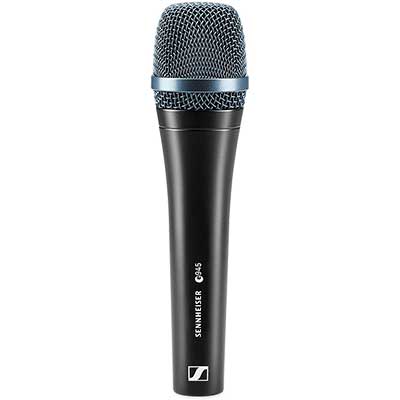
Sennheiser’s super-cardioid microphone. Like the E 935, this microphone is designed to offer dependable quality in whatever kind of climate/performance situation. It’s natural to compare it to the Shure BETA 58A, which is the most comparable super-cardioid mic on the market. Popular opinion is that the Sennheiser wins hands-down in all respects: frequency response, warmth, clarity, aesthetic etc. However, at £210 it’s by far the most expensive microphone on this list. If you’re spending that kind of money on gear and looking to improve the quality of your sound then it might be worth first looking at your choice of amp and considering some kind of extra sound processing equipment before splashing out on a mic.
Price: £210 GBP ($275 USD)
Weight: 0.33 kg (0.73 lbs)
Size: 26.4 x 11.4 x 7.6 cm (0.73 x 10.30 x 4.45 in)
Buy on Amazon
3. AKG
AKG is the third of the three big brands here. They produce a range of professional quality microphones and are around half the price of their Shure equivalents. Many musicians simply prefer the sound of AKG – In London, the AKG D5 seems to be the mic of choice for beatboxers. One musician assured me that AKGs have a more dynamic range, while Shure microphones tend to focus on the midrange. Below are two of the most popular models.
AKG D5 Supercardioid Dynamic Microphone

The AKG D5 is the most popular AKG microphone with street musicians. It’s also the microphone of choice for beatboxers. The D5 is a super-cardioid microphone but there is also the D5C, which is cardioid (see definitions above). The D5s is simply the same model with an on/off switch – so many acronyms!
Price: £53 GBP ($69 USD)
Weight: 0.34 kg (0.75 lbs)
Size: 20 x 7 x 14 cm (0.75 x 7.80 x 2.73 in)
Buy on Amazon
AKG Pro Audio Perception P3S Dynamic Cardiod Microphone
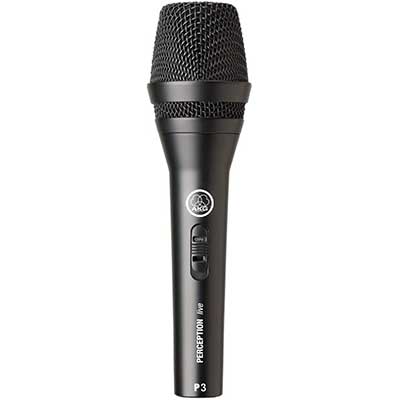
This is a more affordable model from AKG and the cheapest of the branded models here. It’s probably more than adequate for most street musicians. However, if you have aspirations as a singer-songwriter or you think you’ll need a microphone for stage shows then you might want to consider investing in one of the higher quality models.
Price: £28 GBP ($37 USD)
Weight: 0.32 kg (0.70 lbs)
Size: 20.8 x 14 x 6.9 cm (0.70 x 8.11 x 5.46 in)
Buy on Amazon
4. Behringer
Behringer have a reputation for producing music and electronics equipment of a competitive standard for a fraction of the price of some the bigger brands. Some associate the name with low-quality, some with excellent value for money.
Behringer Ultravoice XM8500 Dynamic Cardioid Vocal Microphone
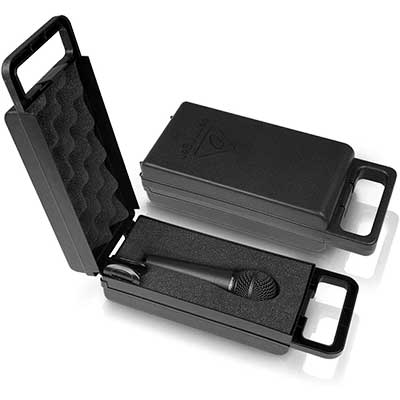
This is one of the most popular busking microphones. The price and the fact it comes with a hard case is a big plus for buskers who do a lot of travelling around.
Price: £28 GBP ($37 USD)
Weight: 0.32 kg (0.70 lbs)
Size: 5.1 x 5 x 1.6 cm (0.70 x 1.99 x 1.95 in)
Buy on Amazon
Behringer BA 85A Dynamic Microphone
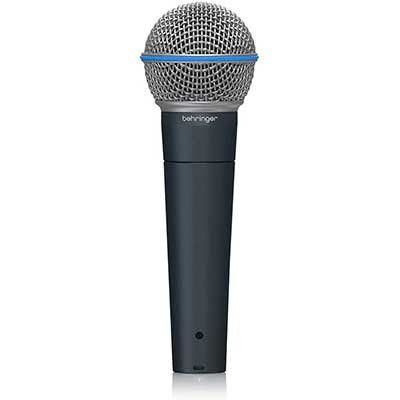
From this microphone’s appearance and name, you might wonder whether Behringer were deliberately trying to mimic the Shure BETA 58A. At less than a fifth of the price, it’s not a bad place to start if you’re looking for an affordable, dynamic, super-cardioid microphone.
Price: £24 GBP ($31 USD)
Weight: 0.66 kg (1.45 lbs)
Size: 16.4 x 16.3 x 5 cm (1.45 x 6.40 x 6.36 in)
Buy on Amazon
Headset Microphones
Whoever’s braved Saturday night busking or playing to a rowdier crowd soon learns that firm “mic-management” is part of the job. Everyone wants a go on the microphone and you can easily find yourself losing control of a performance, having gear broken or stolen, or worse. A good solution is a headset microphone.
There are other reasons for choosing a headset microphone. They don’t need a stand, they’re extremely lightweight and it’s one less thing to faff about with when setting up. It also allows for more freer movement around your pitch and, if you’re playing something like drums or piano, then you don’t have to worry about turning your head to the microphone every time you want to sing.
On the downside, affordable headset mics aren’t generally regarded as offering the same quality as classic microphone models. You also don’t have the option of singing further away or closer to he mouthpiece. Finally – importantly – most headset mics you come across are condenser microphones and aren’t really suited to live singing (see definitions above). That said, there are some dynamic headset microphones designed especially for live vocal performance.
Shure WH20XLR Dynamic Headset Microphone (Wired)
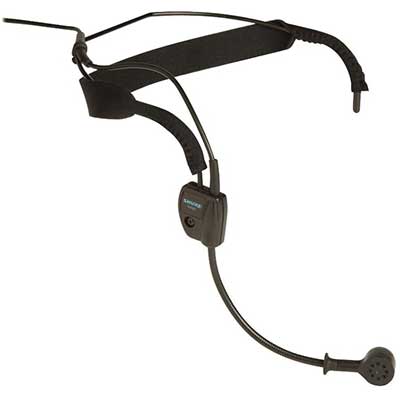
The Shure dynamic, headset microphone could virtually be designed with buskers in mind. It’s travel friendly and able to handle extreme conditions. It’s relatively high-quality and the XLR model uses the same lead as a standard dynamic microphone, with a belt for easy attachment/detachment.
Price: £98 GBP ($128 USD)
Weight: 0.15 kg (0.33 lbs)
Size: 19.6 x 16.3 x 8.1 cm (0.33 x 7.64 x 6.36 in)
Buy on Amazon
Mic Stands
Trying to keep gear as lightweight and portable as possible is always an issue. The microphone itself doesn’t add too much baggage but, unless you’re planning on using a headset mic or holding the mic in your hand, then you’ll also need a stand. A mic stand can also provide a strong grounding point for your show when performing to a larger crowd.
Assuming you’re not driving from pitch to pitch or you have a few roadies to help you, a cheap, lightweight stand is probably most suitable. Below are a few of the models I’ve come across.
Samson MK-10 Microphone Boom Stand
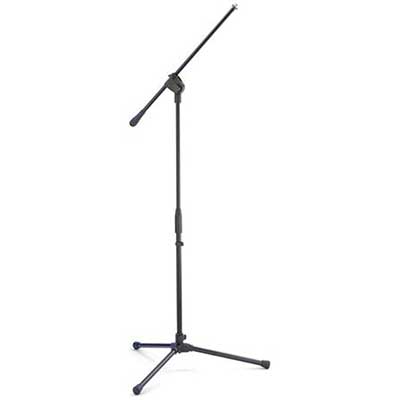
This is the model I use. After lugging around a heavy old stage mic stand for years, this felt like a revelation. As well as being extremely lightweight, the telescopic design means it folds up pretty small. I can imagine situations where you might want something a bit more robust, but I’ve put this through it’s paces and never had any problems at all.
Price: £22 GBP ($29 USD)
Weight: 1.5 kg (3.30 lbs)
Size: 64.8 x 8.9 x 7.6 cm (3.30 x 25.27 x 3.47 in)
Buy on Amazon
Hercules MS432B Stage Series Microphone Boom Stand

For a bit more money, this stand comes with a bit more weight and sturdiness.
Price: £30 GBP ($39 USD)
Weight: 2.1 kg (4.62 lbs)
Size: 80.5 x 9.5 x 9.5 cm (4.62 x 31.40 x 3.71 in)
Buy on Amazon
Tiger Boom Microphone Stand with Mic Clip
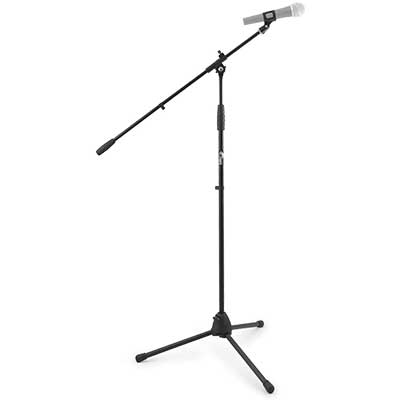
This is about as cheap a mic stand as you’ll find. I’ve not tried it myself but I’ve not heard any stories of them breaking or exploding. If you’re just using it for a mic, it’s probably fine.
Price: £20 GBP ($26 USD)
Weight: 1.7 kg (3.74 lbs)
Size: 86 x 9 x 9 cm (3.74 x 33.54 x 3.51 in)
Buy on Amazon
Finally, a note on types of microphone:
Condenser Vs. Dynamic – Condenser mics are extremely sensitive. They require extra power from the amp (phantom power) and are mostly used in studio recording. Dynamic mics are less sensitive and are more commonly used for live performance. They do not require phantom power. All the mics above are dynamic mics.
Cardioid Vs. Super-Cardioid – This refers to the direction and frequency of sounds that the microphone is designed to pick up. There are a number of nuances. In general, cardioid microphones are easier to work with if you don’t have much technical experience. They are preferred for situations where the singer’s head is likely to be moving around a lot (e.g. when they’re also playing an instrument). With super-cardioid microphones you get a bit more close-up sensitivity (not always desirable). They’re ideal for dedicated vocalists who can maintain good microphone control and want to shut out background noise. They’re sensitivity also makes them good for softer, singer-songwriter style music. The list below includes both cardioid and super-cardioid mics.
Thomas Smolen is a street musician and the Author of 99 Buskers of London: Through the Eyes of London’s Street Musicians, which invites you to explore the world of one of the city’s most iconic subcultures through the eyes of the street musicians themselves.
Donate to The Busking Project
Your donation keeps us in business, and it supports street art all over the world!





